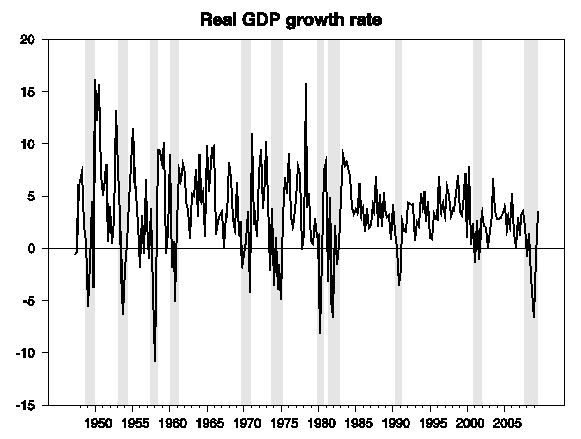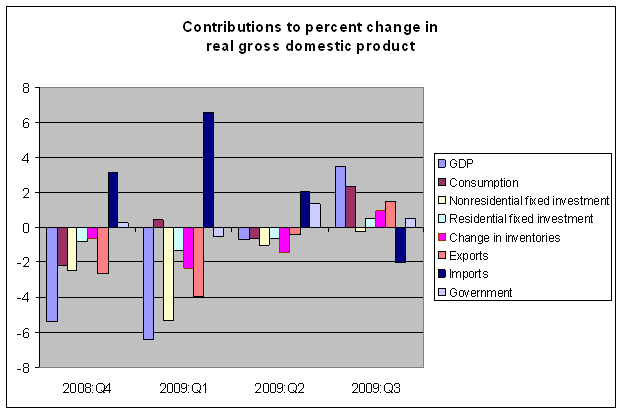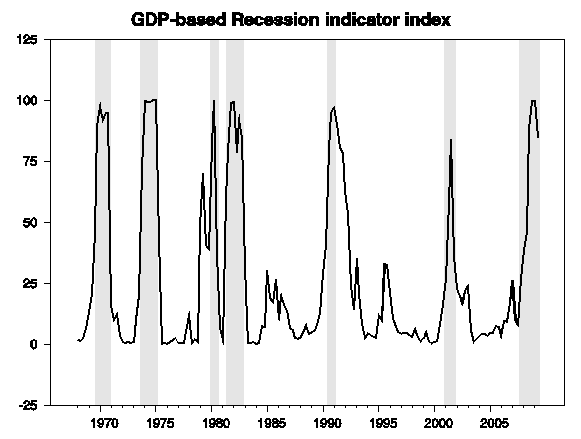The Commerce Department reported today that the seasonally adjusted real value of the nation’s production of goods and services grew at a 3.5% annual rate during the third quarter, a little better than the 3.2% average seen since 1947.

|
Consumption spending is the biggest component of GDP and the main contributor to third quarter growth, accounting by itself for 2.4 percentage points out of the 3.5% total, and with consumer purchases of motor vehicles and parts alone 3/5 of the contribution of consumption. Next in importance was inventory rebuilding, which added 0.9 percentage points to the total and could make a significant further contribution in the quarters ahead. Housing is finally making a positive rather than a negative contribution, and nonresidential fixed investment was a smaller drag than I had been expecting. Imports grew faster than exports, though I’m relieved that trade overall is coming back. The government sector made a smaller contribution than one might have thought given the fiscal stimulus, in part because lower state and local spending offset some of the increased federal spending. For a healthier long-run growth path I’d prefer to see business fixed investment and net exports adding rather than subtracting. But, compared with what we’ve been seeing recently, this overall is a quite welcome report.

With the new third quarter numbers, we are ready to calculate our Econbrowser Recession Indicator Index for the preceding quarter (2009:Q2). This is a pattern recognition algorithm for identifying recessions that waits one quarter for data revisions and clear trend identification before making an assessment. Based on the 2009:Q3 GDP numbers just released, the value that the algorithm assigns to the second quarter of 2009 is 84.6– based on currently available data, it looks like the economy was still in recession as of the second quarter of this year. We’ll declare the recession to be over when the index falls below 33. At that time, we’ll use the full set of revised data available as of that date to assign a most probable date for the end of the recession.

|
Other takes on today’s numbers were provided by
WSJ Real Time,
Calculated Risk,
Jon Hilsenrath,
Economix,
and Justin Fox,
whose general theme seems to be concerns about whether this growth will be sustained into 2010.
What is kind of disappointing is that there is nothing new in this recovery. Housing and cars – same old, same old. There was so much promise at the beginning: green energy-efficient technology, re-balancing toward innovation and industrial production away from financial “production” and “innovation”. All came to nothing, old habits die hard.
And let me guess the remaining 2/5 of the 2.4% PCE contribution came from the expenditure of wealthy (http://www.nakedcapitalism.com/2009/10/wealthy-ramp-up-their-spending-so-all-must-be-well.html ). That’s almost a 1% of GDP, not trivial. There is a moral in all data somewhere…
Unwilling to change of topic but candidly thinking that economics is a metrix that has to be studied through its all components (Rien ne se perd,rien ne se cree mais tout se transforme):
GDP growth (cause for rejoycing) but at wich price ?
GDP growth, a factor of expansion? or regression through debts? When reading Rogoff C Reinhart it is noticeable that overall trough 1960 till 2010 sovereign debts crisis have been quiet subdued (Asia , Latin America) compared to the previous periods (Fig 1 p5)
This Time is Different: A Panoramic View of Eight Centuries of
Financial Crises*
Carmen M. Reinhart, University of Maryland and NBER
Kenneth S. Rogoff, Harvard University and NBER
Reading the above in conjunction with the IMF debts extrapolation may provide for more thoughts.Is the solution driving towards more problems that is a sovereign debts crisis?
INTERNATIONAL MONETARY FUND
The State of Public Finances:
Outlook and Medium-Term Policies After the 2008 Crisis
Prepared by the Fiscal Affairs Department
In cooperation with other departments
Approved by Carlo Cottarelli
March 6, 2009
Contents
We will have a second recession in 2011.
0% FF rate + $8000 credit is the only thing keeping the housing market from correcting fully. On top of that, taxes rise on 1/1/2011.
Looks like we will get a short not so deep recession W in Q4 2010- Q1 2011.
My take is essentially, this was driven by the shift in consumption brought about by the Cash for Clunkers, doubt whether the stimulus helped all that much, and fear that the year to year change in investment and inventories shows a bleak 4th quarter unless something else breaks.
My take: http://learnecon.blogspot.com/2009/10/government-purchases-35-growth-rate-but.html
you can see the motor vehicle impact quite clearly:
http://www.bea.gov/national/nipaweb/TableView.asp?SelectedTable=16&Freq=Qtr&FirstYear=2007&LastYear=2009
if you believe this brought auto consumption forward, i don’t see how this is a good story
same goes for housing
Nominal, nominal, nominal. Put the Kool-Aid down professor.
Because we know, at this stage, that government dollars are so much worse than private-sector dollars. Truly we have reached a dark age for this discipline.
In case it is over, was it really the deepest and longest recesssion since Great Depression?
Don’t miss that the GDP number includes increased government stimulus spending (look at the deficit)
I suppose if you ignore some things, then things look rosy.
This last may imply that we will get a one-time bounce inventory bounce later
And of course many of the inputs to the numbers are “One Hit Wonders”
Are we so desperate for “good news” that we will ignore huge swathes of reality to get it? Apparently so.
How much of GDP is based on currency denominated debt?
What people are missing when analyzing this GDP report is that “cash-for-clunkers” was actually a drag on the economy. While domestic consumption of autos increased, imports of autos increased even more. I run through the numbers here:
http://www.tylernewton.com/blog/2009/10/assessing-the-quality-of-q3-gdp-growth.html
GDP growth was actually more broad-based than people seem to think.
Perhaps now might be a good time to ask what happened to employment. Keynes, in the General Theory, was focused on employment. The Malthus-Say debate was about employment.
When exactly did the shift occur to “output”? Particularly the abstracted, deflated, owner-equivalent-rent-hedonic-adjusted output?
For the next twelve months, real GDP will grow by 1% according to my model, which would have outperformed every single of the 50 or economists polled by the Wall Street Journal in the past few years. See http://raphaelkahan.blogspot.com/2009/11/gdp-forecast-update.html